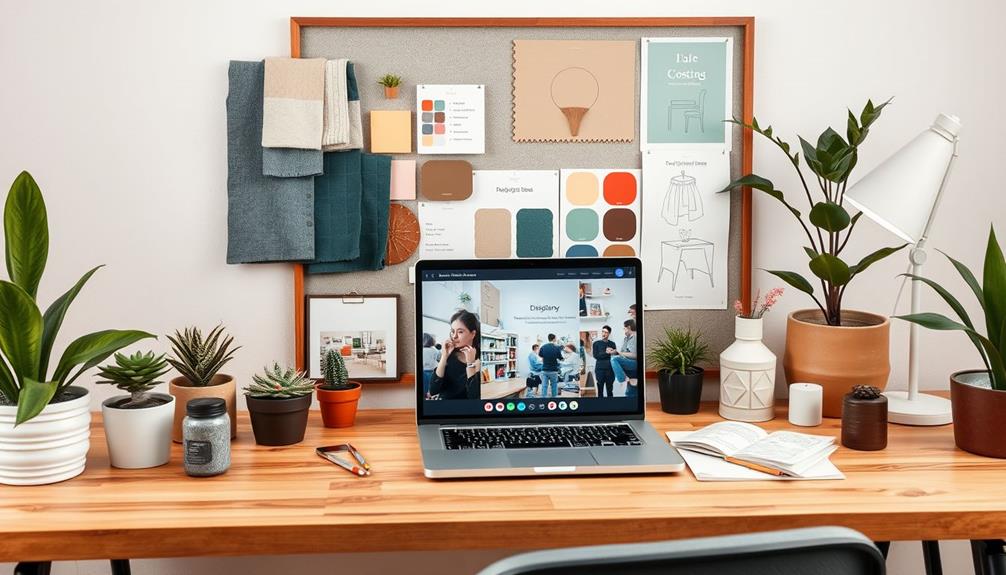To learn 3D rendering for interior design, start with user-friendly software like SketchUp or Blender. Online platforms like Udemy offer courses specifically tailored to interior design, often at budget-friendly prices. Focus on mastering the basics, such as modeling, applying materials, and setting up lighting. Utilize tutorials to enhance your skills in photorealistic rendering and texturing. Experiment with different techniques to build a strong foundation. Once you've got a grasp on the essentials, you'll find ways to elevate your designs further. Explore more options to refine your craft and boost your confidence in creating stunning visual presentations.
Key Takeaways
- Start with user-friendly software like SketchUp or Blender to build foundational 3D modeling skills for interior design.
- Explore comprehensive online courses on platforms like Udemy to learn rendering techniques specific to interior design.
- Practice the step-by-step rendering process, from initial concept development to final output, ensuring clarity in each phase.
- Utilize effective lighting and texturing techniques to enhance realism in your 3D models, simulating natural and artificial light sources.
- Present designs from multiple perspectives and offer virtual tours to engage clients and gather feedback for improvements.
Importance of 3D Rendering
3D rendering has transformed the way interior designers communicate their ideas. With stunning visualizations, you can clarify your design intent, reducing misunderstandings and revisions with clients. This technology allows you to explore multiple design options efficiently, experimenting with various materials, layouts, and lighting before making final decisions.
By incorporating 3D Interior Design into your workflow, you'll greatly increase your project approval rates. Clients are much more likely to endorse designs they can visualize thoroughly, making your presentations more impactful.
Additionally, 3D rendering helps you identify potential design issues early in the design process. This proactive approach saves both time and resources, preventing costly alterations during construction.
As client expectations continue to evolve, embracing 3D rendering has become essential for staying competitive in the interior design industry. You'll find that adopting this technology enhances your communication with clients, ensuring you meet their needs and preferences effectively.
Essential Software Tools

To effectively bring your design concepts to life, choosing the right software tools is key. The right tools can elevate your 3D interior design projects, allowing for stunning interior rendering and detailed presentations.
Here are three essential software tools you should consider:
- SketchUp: This versatile modeling software is perfect for creating quick 3D models. Its user-friendly interface makes it great for both beginners and experienced designers.
- 3ds Max: Known for its advanced texturing capabilities, 3ds Max excels in creating photorealistic visuals. It pairs well with rendering engines like V-Ray and Lumion, enhancing the quality of your presentations.
- Chief Architect: Ideal for intuitive design, Chief Architect allows seamless shifts from 2D floor plans to 3D models. It's user-friendly and offers specialized tools for interior design.
Don't forget to utilize Adobe Photoshop for post-render editing. It can notably enhance your designs with visual effects and detailed adjustments.
Keeping your software and plugins updated is vital for maintaining high rendering quality and speed in your projects.
Learning Resources and Courses

When you're ready to enhance your 3D rendering skills, online learning platforms offer a wealth of courses tailored for interior design.
You can find everything from extensive software tutorials to specialized classes that focus on specific techniques.
These resources not only save you time but also provide you with expert insights to elevate your design projects.
Online Learning Platforms
In today's digital age, online learning platforms have become invaluable resources for mastering 3D rendering in interior design. You can easily access courses that cover essential skills and software tools, making it easier than ever to learn 3D interior design.
Here are three reasons to explore these platforms:
- Comprehensive Courses: Platforms like Udemy offer courses such as "Learn 3D Interior Designs," rated 3.9/5, providing lifetime access and practical training on popular interior design software like SketchUp and Blender.
- Accessible Pricing: With frequent discounts, you can find valuable courses, such as "Material Trends for Interiors" for just $9.99, making high-quality education accessible for aspiring designers.
- Expert Instructors: Many instructors, like Salaimanimagudam M.P., are seasoned professionals, ensuring you receive exceptional guidance in rendering in your design projects.
Whether you're looking to enhance your interior design services or just starting, online platforms for interior design offer practical ways on getting the skills you need.
Don't hesitate to use different apps that let you try these tools, and explore options like Udemy Business for tailored learning solutions.
Recommended Software Tutorials
Finding the right software tutorials is fundamental for mastering 3D rendering in interior design. Start with a SketchUp Course that covers the fundamentals of 3D modeling, focusing on creating detailed interior design models. This hands-on experience is essential for understanding the rendering process.
For those looking to save money, Blender Tutorials available on free online platforms and YouTube can enhance your skills. These resources emphasize rendering techniques specific to interior spaces, making them a great option for beginners and advanced users alike.
If you want in-depth training, explore 3ds Max Training courses on platforms like Udemy. These courses emphasize photorealistic rendering and material application, crucial for effective design rendering in interior design projects.
Don't overlook AutoCAD Resources, which are fundamental for creating 2D and 3D floor plans. Understanding spatial relationships through these tutorials is key to successful interior layouts.
Lastly, consider specialized courses on V-Ray Integration with your 3D modeling software. Mastering realistic lighting and texturing techniques will elevate your rendering skills, providing you with Interior Design: Useful Tips to create stunning visualizations.
Step-by-Step Rendering Process

To kick off your rendering process, start by developing an initial concept using reference images or sketches that capture your vision.
Next, you'll create a detailed 3D model, organizing your design for clarity.
Initial Concept Development
Starting the rendering process involves gathering reference images or sketches that capture the style and elements you want for your interior space. This initial concept development is essential as it guides your modeling direction.
Here's how to proceed effectively:
- Select Reference Material: Choose images that inspire your design ideas and represent the colors, shapes, and textures you plan to use.
- Utilize 3D Modeling Software: Begin crafting your initial model in your chosen software. Use tools to draw lines and shapes, extruding them into three-dimensional forms while keeping your project organized with layers.
- Apply Textures and Materials: Use the material editor to apply textures and materials. Adjust properties like diffuse and reflection to create a realistic representation of surfaces.
After establishing these elements, set up your lighting by incorporating both natural and artificial sources.
Adjust their intensity and color to create ambient effects that enhance realism. Following this structured approach will set you up for a successful rendering process, ultimately allowing you to create stunning virtual tours of your designs.
3D Model Creation
When diving into 3D model creation, it's important to have a clear vision of your desired interior space. Start by referencing images or sketches related to your design project to guide you.
Use your chosen software's tools to draw lines and shapes, extruding them to form the basic structure of your model. Organizing elements using layers and groups will streamline your workflow.
Next, focus on applying materials and textures through the material editor. Adjust properties like diffuse and reflection to achieve a realistic representation of surfaces, which is vital for effective 3D Interior Design.
Once your model looks great, incorporate both natural and artificial lighting sources. Adjust their intensity and color to enhance the overall ambiance and realism of the space.
Rendering Techniques and Tools
With your detailed 3D model complete, it's time to explore rendering techniques and tools that bring your design to life. The rendering process transforms your 3D interior design into a stunning visual representation, and here's how to proceed:
- Apply Textures and Materials: Use the material editor to apply realistic textures and materials. Adjust properties like diffuse and reflection to align with your design intent.
- Set Up Lighting: Incorporate both natural and artificial light sources. Modify properties such as intensity and color to enhance the ambiance and realism of your space.
- Choose Rendering Engines: Select plugins and rendering engines like V-Ray or Lumion. These tools elevate your final output, so stay updated with software enhancements that improve rendering capabilities.
Once you've finalized the model, textures, and lighting setup, render the scene using appropriate settings that balance quality and speed.
This step produces a 2D image or animation of your interior space, showcasing your design effectively.
Tips for Effective Modeling

Effective modeling in 3D rendering can greatly elevate your interior design projects, so it's crucial to begin with the right tools and techniques. Start with user-friendly software like SketchUp or Blender, both of which provide a solid foundation for mastering 3D interior design.
Utilize online resources such as tutorials and courses to learn specific modeling techniques tailored to your needs.
Begin by practicing simple geometric shapes, gradually moving on to more complex forms. This approach guarantees that you understand key tools for drawing, extruding, and manipulating objects effectively.
As you build your skills, make certain to organize your workspace by using layers and groups within your software. This organization helps maintain clarity and enhances your navigation during the design process.
Don't forget to regularly review and analyze professional models. This practice exposes you to advanced techniques and styles, which you can incorporate into your own work.
Enhancing Realism With Textures

Textures can transform your 3D interior renderings from basic to breathtaking. By effectively applying textures, you'll greatly enhance realism, adding depth and detail that make surfaces come alive.
Here are three key strategies to elevate your work:
- Utilize Material Editors: Adjust properties like diffuse color, reflection, and bump mapping within your software's material editors. This allows you to create more convincing textures that mimic real-world materials.
- Incorporate High-Resolution Images: Use high-resolution images of authentic materials, such as wood grain or fabric patterns, as texture maps. This approach is vital for achieving photorealistic finishes in your designs.
- Experiment with Layering Textures: Combine multiple textures to create complex surfaces. For instance, layering a wood texture with a glossy finish on cabinetry can simulate a realistic look that enhances the overall design.
Always consider scale and orientation when applying textures to guarantee they align accurately with real-world proportions.
Lighting Techniques for Impact

To make your 3D interior designs truly stand out, you need to light them up strategically. Employing effective lighting techniques can transform your interior space, adding depth and visual interest.
Start by using a combination of ambient, task, and accent lighting to create a balanced atmosphere that suits the room's function. Ambient lighting sets the overall mood, task lighting focuses on specific activities, and accent lighting highlights key features, like architectural details or artwork.
Utilize your 3D rendering software to simulate natural light changes throughout the day. This natural light simulation helps clients visualize how lighting affects the mood and appearance of the space.
Adjust the intensity, color temperature, and shadow properties to evoke specific emotional impacts, whether it's warmth or calmness.
Don't forget to incorporate reflective surfaces in your designs. They enhance lighting effects, making your renderings more dynamic and engaging.
Presenting Your Final Designs

A successful presentation of your final designs can make all the difference in conveying your vision to clients. To achieve this, focus on three key elements:
- High-Quality Renderings: Utilize photorealistic techniques to create stunning 3D Interior Design visuals. Incorporate realistic finishing elements like furniture, decor, and lighting to enhance the lifelike ambiance of your designs.
- Multiple Perspectives: Showcase your design's versatility by presenting 3D renderings from various angles, including aerial and eye-level shots. This helps clients grasp spatial relationships and better understand your design intent.
- Virtual Tours: Engage clients by offering virtual tours of your designs. This interactive experience allows them to explore the space, making it easier to visualize and connect with your concepts.
After presenting, gather client feedback to fine-tune your designs. Implementing their suggestions guarantees the final product aligns with their vision and expectations, creating a collaborative atmosphere.
Conclusion
In the world of interior design, mastering 3D rendering can truly set you apart. By embracing essential software, honing your skills, and applying effective techniques, you'll be well on your way to creating stunning visuals that captivate clients. Remember, practice makes perfect—don't be afraid to experiment and learn from your mistakes. As you commence on this journey, you'll find that every design is a stepping stone to success, and soon, you'll be turning heads with your work.








